Discrete Element Numerical Simulation of the Effect of River Ice Porosity on Impact Force at Bridge Abutments
Abstract
:1. Introduction
2. Materials and Methods
2.1. Discrete Elemental Computational Modeling of River Ice
2.2. Overview of the Abutment Project
2.3. Discrete Elemental Model of River Ice
2.4. Validation of DEM
2.5. Parameter Range Selection
3. Results and Discussion
3.1. Influence of Ice Velocity on River Ice Impact Forces at Bridge Abutments
3.2. Influence of Ice Raft Thickness on River Ice Impact Forces at Bridge Abutments
3.3. Influence of Porosity on River Ice Impact Forces at Bridge Abutments
3.4. Construction of a Dynamic Load Model for River Ice Impacted Bridge Piers
3.4.1. Peak Impact Force
3.4.2. Time Parameter
- Time of onset of river ice impact.As shown in Figure 12,with the increase in porosity, the degree of ice row loosening increases accordingly, and the piers need a longer time to reach the maximum destructive force when penetrating the river ice. According to the simulation results, with the increase in porosity, the onset time of river ice splitting increases, and the peak of contact force is gradually lagged. The relationship between river ice porosity and the onset time of impact is obtained by fitting, as shown in Figure 10. Changes in river ice velocity and ice thickness have a small effect on the onset time, so the onset time is expressed as a function of porosity .
- 2.
- Load time and unload time.As presented in Table 3, with the increase in river ice porosity and river ice velocity, the time for the impact force to reach the peak and the time for the impact force to fall back from the peak both become shorter, and the loading time of the river ice impact is obviously faster than the unloading time, while the thickness of the ice raft has little effect on the loading time and unloading time of the river ice. The increase in river ice porosity reduces the strength of the river ice, the ice raft reaches its strength limit faster, the increase in velocity makes the stress on the ice raft accumulate more rapidly, generating more kinetic energy, and the loading time and unloading time of ice raft failure are shortened accordingly. According to the simulation results, the relationship between load time , unload time and is plotted and fitted, as shown in Figure 13. The load time and unload time of the river ice are expressed as a function of .
3.4.3. Load Model Validation
3.5. Engineering Applications
4. Conclusions
- (1)
- The simulation results indicate that increased ice speed significantly raises river ice impact force. When the speed of the ice reaches a certain critical threshold, the maximum impact force no longer increases with further increases in velocity. Instead, this peak impact force becomes more influenced by the strength of the ice. This finding is crucial for understanding how river ice interacts with bridges under extreme conditions.
- (2)
- The effect of river ice porosity on the impact force is also significant. As the porosity increases, the ice load decreases overall, while a lag occurs in the appearance of the peak contact force. In addition, the random loading and unloading characteristics of the ice load are enhanced, indicating that the change in porosity increases the uncertainty of the impact process, which puts forward higher requirements for the ice-resistant design of bridges in cold regions.
- (3)
- Regarding the damage pattern of ice rafts, it is found that with the increase in porosity, the damage is gradually concentrated near the area in direct contact with the bridge abutments. Therefore, emphasis should be placed on strengthening the protective capacity of the abutment-susceptible area to effectively resist the threat of ice collision.
- (4)
- According to the fitting results of the relationship between the river ice porosity and the maximum impact force, as well as each time parameter, the maximum impact force of the river ice gradually decreases with the increase in river ice porosity, and the fitting results show an obvious nonlinear relationship; the start time of the impact load increases with the increase in the porosity, and the loading time and unloading time decreases with the increase in the porosity and the ice speed. When analyzing and predicting the ice load on the structure, the effect of river ice porosity and the characteristics of the ice load model need to be fully considered.
- (5)
- This study focuses on revealing the effect of porosity on ice impact force but is limited by the model simplification: it has not yet covered the actual ice morphology diversity and impact location effect. The subsequent study will combine the discrete element modeling of U-shaped ice and irregular ice rows with the sensitivity analysis of the impact location, coupling multiple parameters, and providing domain-wide theoretical support for the ice-resistant design of bridges in cold regions.
Author Contributions
Funding
Institutional Review Board Statement
Informed Consent Statement
Data Availability Statement
Acknowledgments
Conflicts of Interest
References
- Beltaos, S. River ice jams: Theory, case studies and applications. J. Hydraul. Eng. 1983, 109, 1338–1359. [Google Scholar] [CrossRef]
- Matlock, H.; Dawkins, W.P.; Panak, J.J. Analytical Model for Ice-Structure Interaction. J. Eng. Mech. Div. 1971, 97, 1083–1092. [Google Scholar] [CrossRef]
- Wong, C.K.; Brown, T.G. A Three-Dimensional Model for Ice Rubble Pile-Ice Sheet-Conical Structure Interaction at the Piers of Confederation Bridge, Canada. J. Offshore Mech. Arct. Eng. 2018, 140, 051501. [Google Scholar] [CrossRef]
- Hendrikse, H.; Metrikine, A. Interpretation and prediction of ice induced vibrations based on contact area variation. Int. J. Solids Struct. 2015, 75, 336–348. [Google Scholar] [CrossRef]
- Withalm, M.; Hoffmann, N. Simulation of full-scale ice–structure-interaction by an extended Matlock-model. Cold Reg. Sci. Technol. 2010, 60, 130–136. [Google Scholar] [CrossRef]
- Zhang, S.F.; Yu, T.L. The Factors Sensitivity Analysis of Drift Ice Impact Force on the Pier. Adv. Mater. Res. 2014, 852, 472–475. [Google Scholar] [CrossRef]
- Zhang, L.Z.; Xiong, W. Numerical Simulations of the Drifting Ice Sheets Collision with the Bridge Pier. Appl. Mech. Mater. 2013, 368, 1383–1386. [Google Scholar] [CrossRef]
- Tuhkuri, J.; Polojärvi, A. A review of discrete element simulation of ice–structure interaction. Philos. Trans. R. Soc. A Math. Phys. Eng. Sci. 2018, 376, 20170335. [Google Scholar] [CrossRef] [PubMed]
- Kärnä, T.; Turunen, R. Dynamic response of narrow structures to ice crushing. Cold Reg. Sci. Technol. 1989, 17, 173–187. [Google Scholar] [CrossRef]
- Timco, G.W.; Nwogu, O.G.; Christense, F.T. Compliant model tests with the Great Belt West Bridge piers in ice Part II: Analyses of results. Cold Reg. Sci. Technol. 1995, 23, 165–182. [Google Scholar] [CrossRef]
- Iliescu, D.; Baker, I. The structure and mechanical properties of river and lake ice. Cold Reg. Sci. Technol. 2007, 48, 202–217. [Google Scholar] [CrossRef]
- Lu, Q.; Duan, Z.; Ou, J.; Wang, Z. Calculational method of river ice loads on piers (II): The formula for ice pressure. J. Nat. Disasters 2002, 11, 112–118. [Google Scholar] [CrossRef]
- Jones, S.J. High Strain-Rate Compression Tests on Ice. J. Phys. Chem. B 1997, 101, 6099–6101. [Google Scholar] [CrossRef]
- Moslet, P. Field testing of uniaxial compression strength of columnar sea ice. Cold Reg. Sci. Technol. 2007, 48, 1–14. [Google Scholar] [CrossRef]
- Cole, D.M. The microstructure of ice and its influence on mechanical properties. Eng. Fract. Mech. 2001, 68, 1797–1822. [Google Scholar] [CrossRef]
- Kharik, E.; Morse, B.; Roubtsova, V.; Fafard, M.; Côté, A.; Comfort, G. Numerical studies for a better understanding of static ice loads on dams. Can. J. Civ. Eng. 2018, 45, 18–29. [Google Scholar] [CrossRef]
- Yue, Q.; Guo, F.; Kärnä, T. Dynamic ice forces of slender vertical structures due to ice crushing. Cold Reg. Sci. Technol. 2009, 56, 77–83. [Google Scholar] [CrossRef]
- Sun, S.; Shen, H.H. Simulation of pancake ice load on a circular cylinder in a wave and current field. Cold Reg. Sci. Technol. 2012, 78, 31–39. [Google Scholar] [CrossRef]
- Hopkins, M.A. Discrete element modeling with dilated particles. Eng. Comput. 2004, 21, 422–430. [Google Scholar] [CrossRef]
- Hopkins, M.A.; Shen, H.H. Simulation of pancake-ice dynamics in a wave field. Ann. Glaciol. 2001, 33, 355–360. [Google Scholar] [CrossRef]
- Shen, H.H.; Hibler, W.D.; Leppäranta, M. The role of floe collisions in sea ice rheology. J. Geophys. Res. Oceans 1987, 92, 7085–7096. [Google Scholar] [CrossRef]
- Jiang, M.; Shen, Z.; Wang, J. A novel three-dimensional contact model for granulates incorporating rolling and twisting resistances. Comput. Geotech. 2015, 65, 147–163. [Google Scholar] [CrossRef]
- Hillerborg, A.; Modéer, M.; Petersson, P.-E. Analysis of crack formation and crack growth in concrete by means of fracture mechanics and finite elements. Cem. Concr. Res. 1976, 6, 773–781. [Google Scholar] [CrossRef]
- Liu, H. Study on Physical and Mechanical Properties of River Ice by Test and Discrete Element Numerical Simulation. Master’s Thesis, Harbin Institute of Technology, Harbin, China, 2022. [Google Scholar] [CrossRef]
- Yang, Q.; Song, K.; Hao, X.; Wen, Z.; Tan, Y.; Li, W. Investigation of spatial and temporal variability of river ice phenology and thickness across Songhua River Basin, northeast China. Cryosphere 2020, 14, 3581–3593. [Google Scholar] [CrossRef]
- Timco, G.W.; Weeks, W.F. A review of the engineering properties of sea ice. Cold Reg. Sci. Technol. 2010, 60, 107–129. [Google Scholar] [CrossRef]
- Li, Z.; Zhang, L.; Lu, P.; Leppäranta, M.; Li, G. Experimental study on the effect of porosity on the uniaxial compressive strength of sea ice in Bohai Sea. Sci. China Technol. Sci. 2011, 54, 1331–1334. [Google Scholar] [CrossRef]

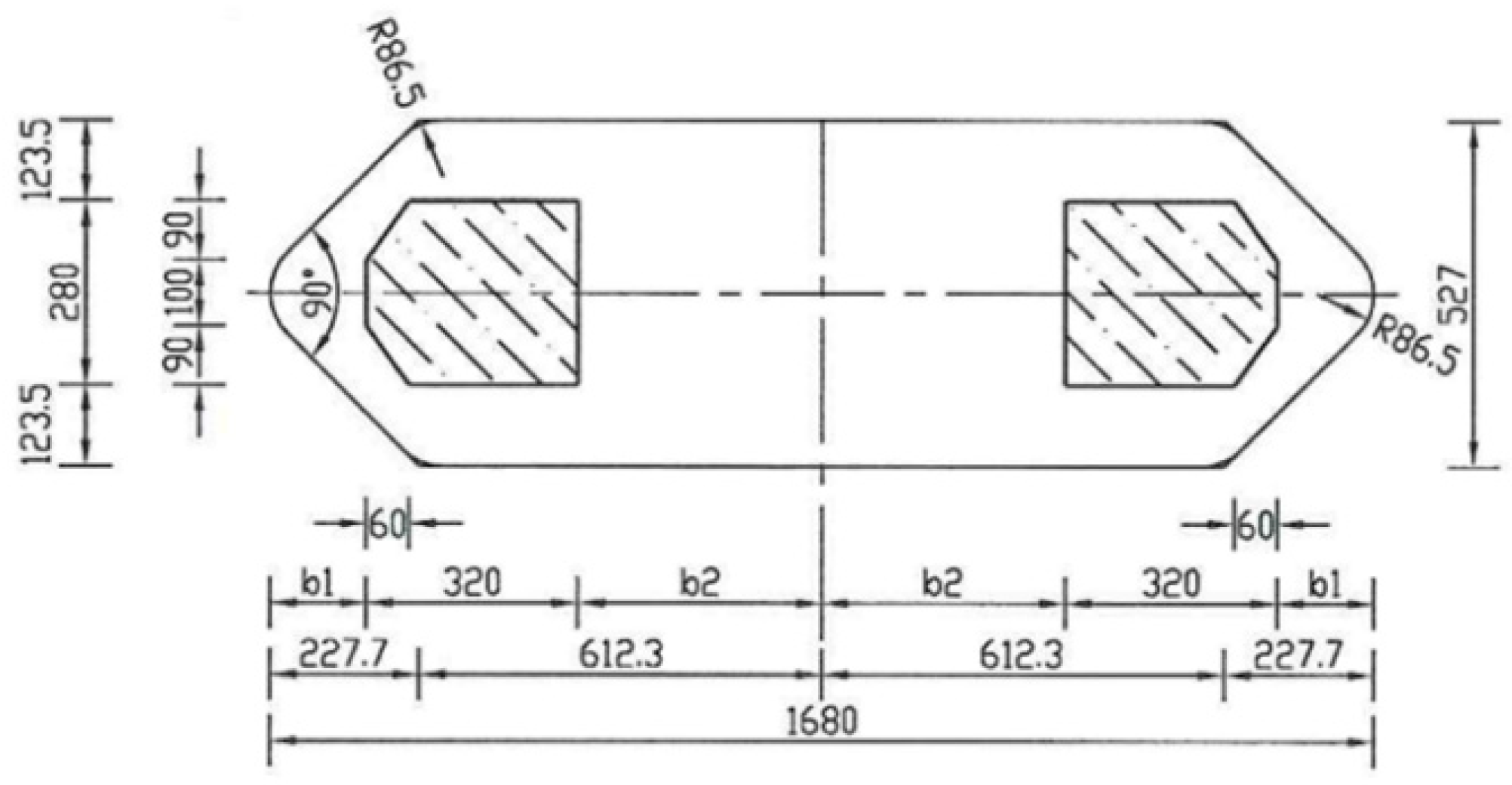

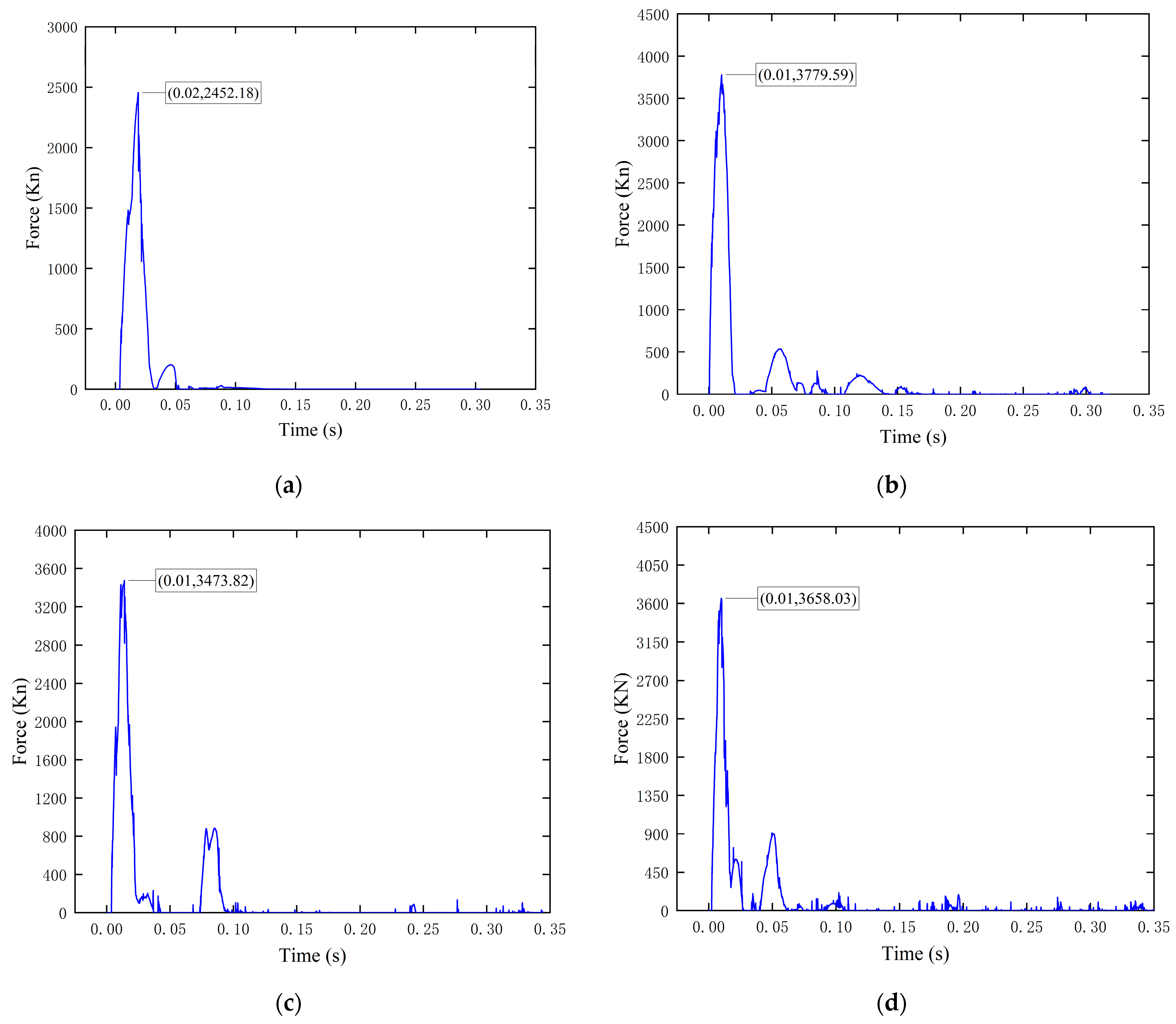
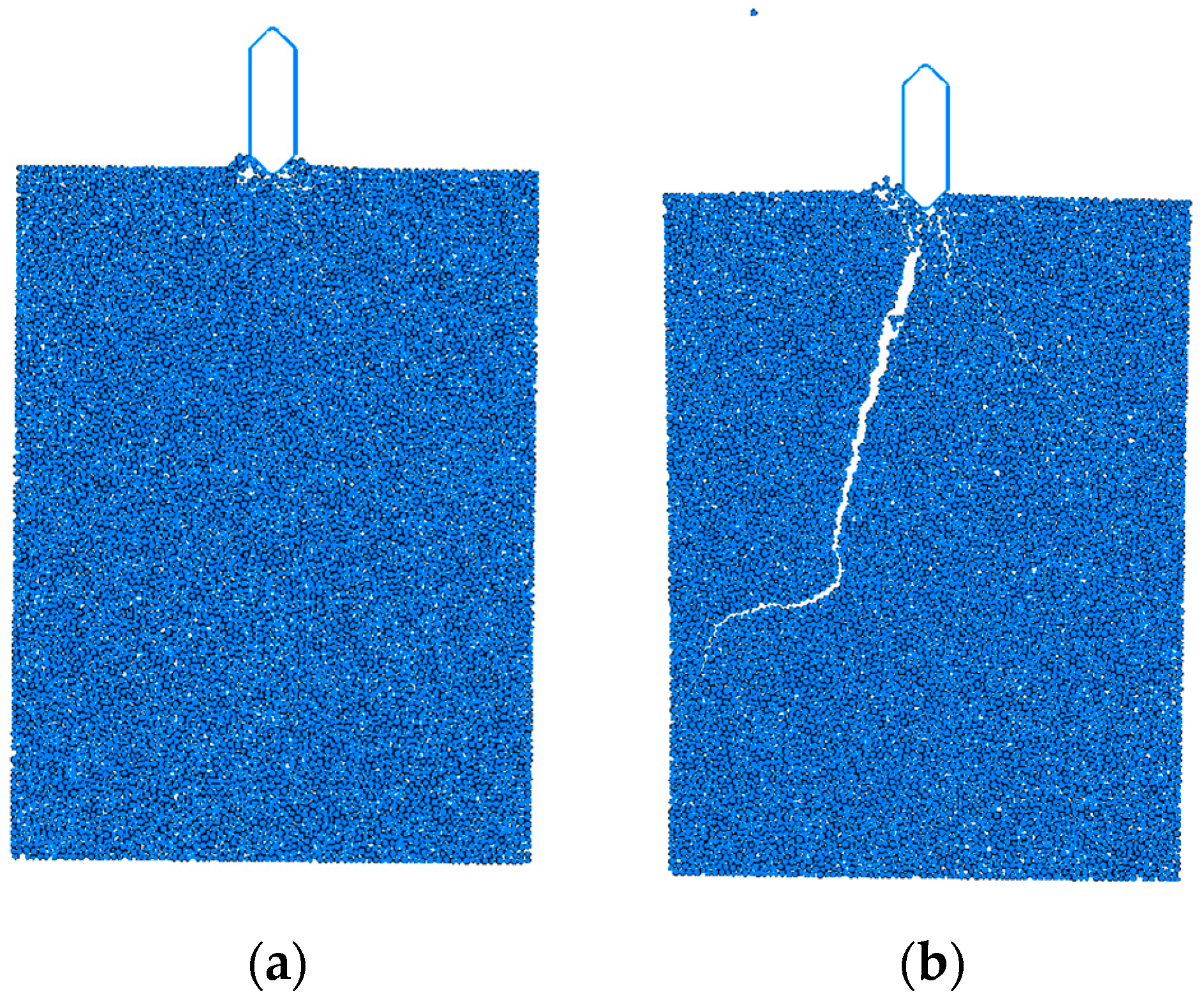
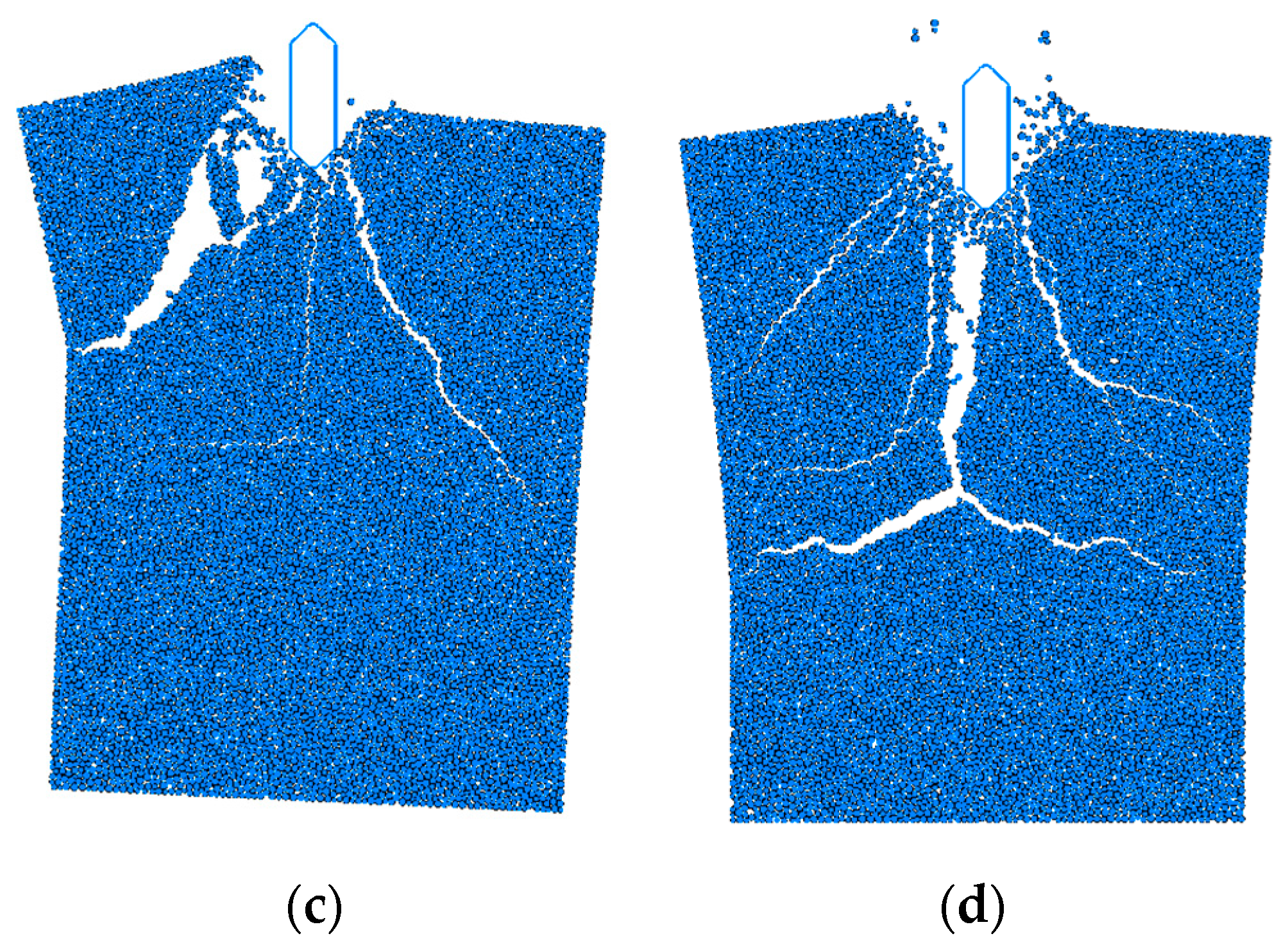
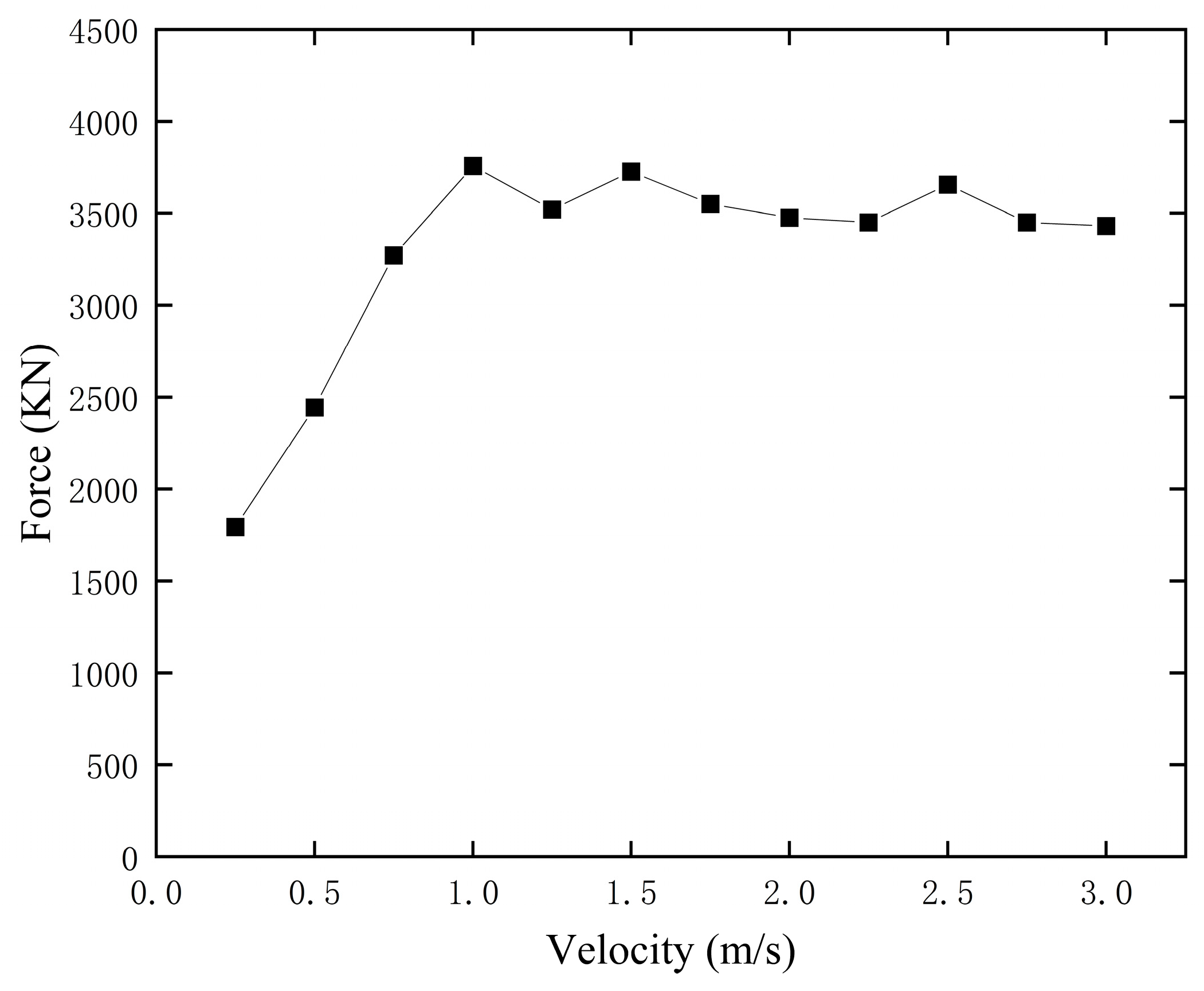

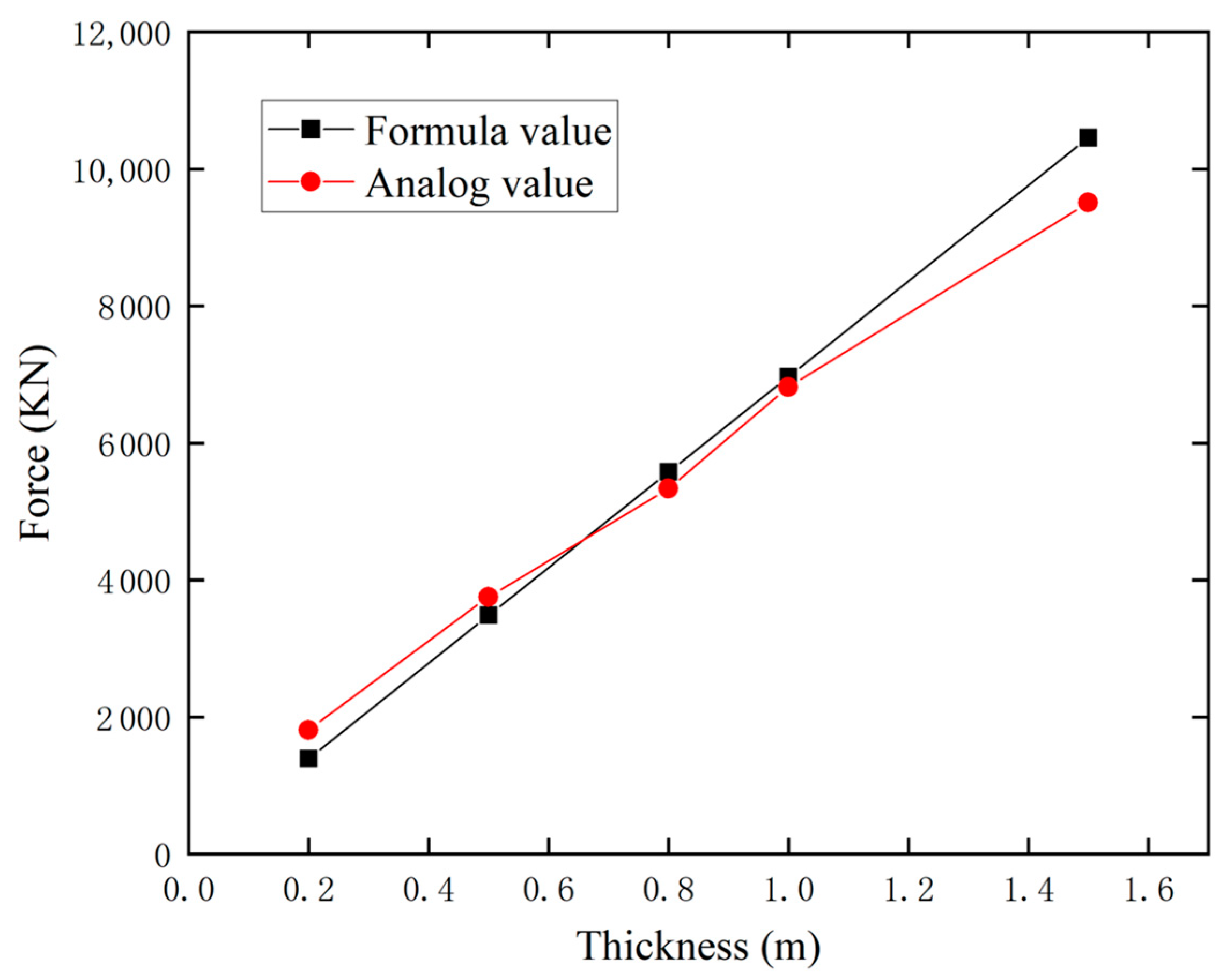
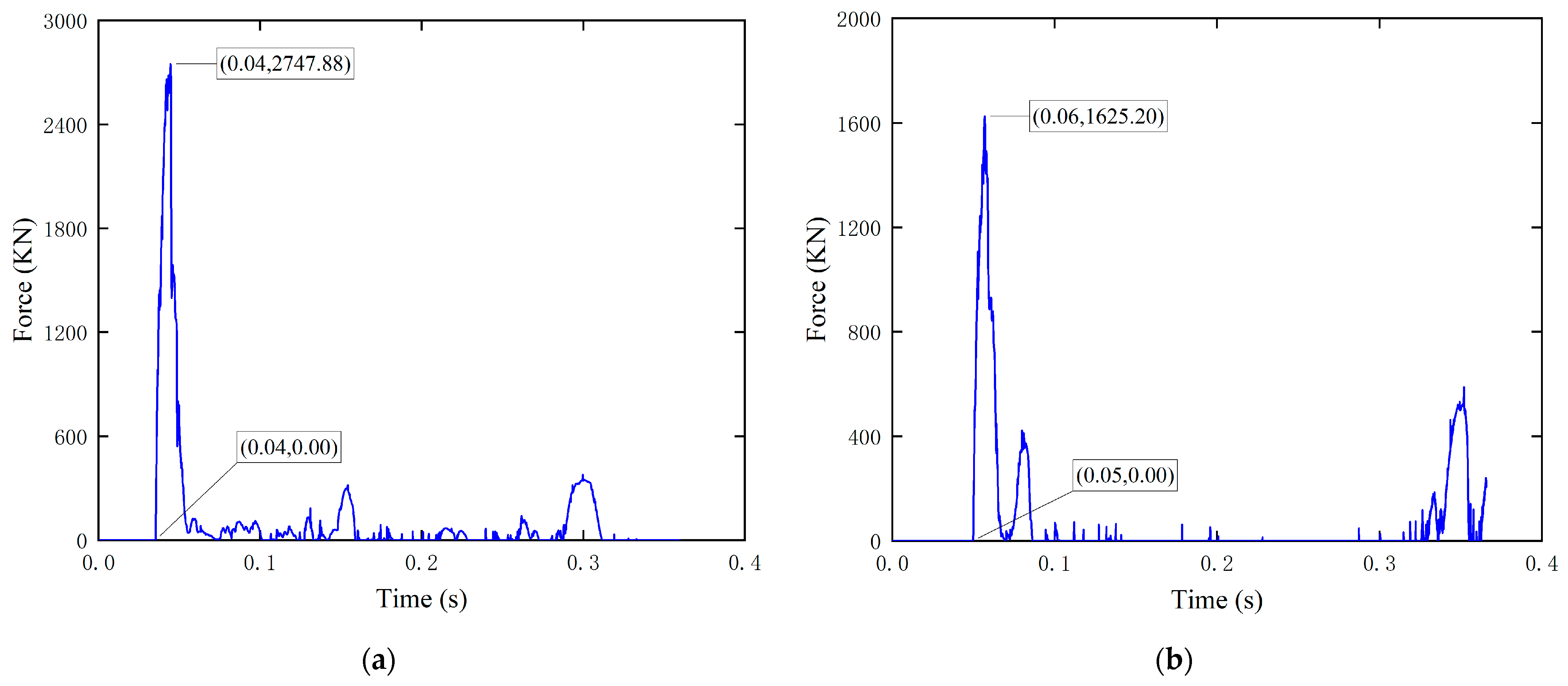
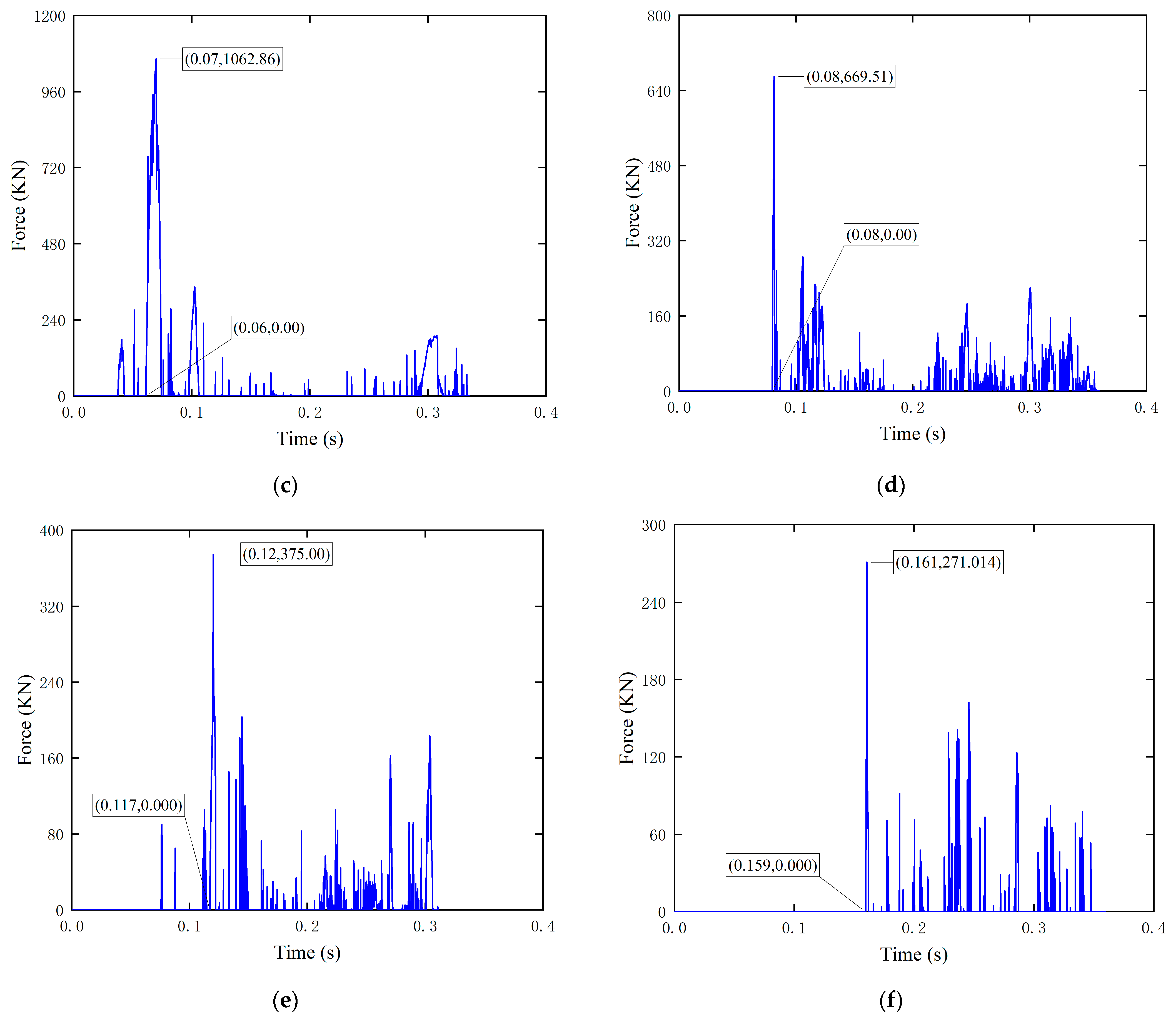

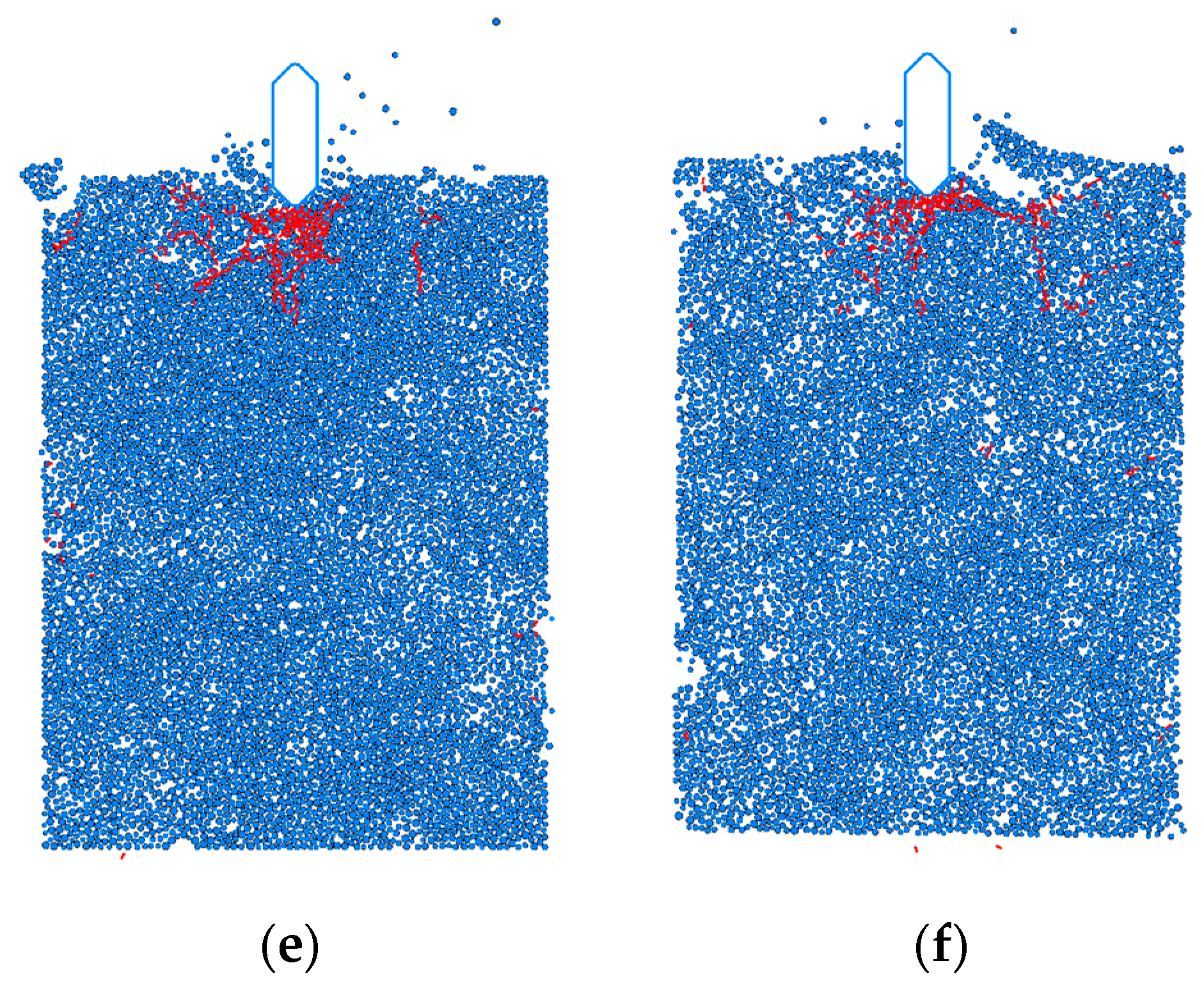




| River Ice Fine View Parameters | Reference Point |
|---|---|
| Elastic modulus | 0.38 Gpa |
| Tangential normal stiffness ratio | 1 |
| Tensile strength | 0.43 Mpa |
| Bond strength | 1.32 Mpa |
| Angle of friction | 0° |
| Coefficient of friction | 0.1 |
| Damping ratio coefficient | 0 |
| Porosity | Ice Load Extreme/KN |
|---|---|
| 0.05 | 2739.8 |
| 0.1 | 1625.19 |
| 0.15 | 1062.8 |
| 0.2 | 669.1 |
| 0.25 | 375 |
| 0.3 | 271 |
| Porosity | Velocity (m/s) | Ice Thickness (m) | Onset Time (s) | Load Time (s) | Unload Time (s) |
|---|---|---|---|---|---|
| 0 | 1 | 0.5 | 0.0004 | 0.0109 | 0.0168 |
| 1 | 0.0009 | 0.0098 | 0.0188 | ||
| 1.5 | 0.0006 | 0.0117 | 0.0155 | ||
| 0.05 | 1 | 0.5 | 0.04 | 0.0104 | 0.0151 |
| 2 | 0.036 | 0.0065 | 0.0113 | ||
| 3 | 0.032 | 0.005 | 0.0085 | ||
| 0.1 | 1 | 0.5 | 0.050 | 0.0084 | 0.0116 |
| 2 | 0.044 | 0.0048 | 0.0089 | ||
| 3 | 0.048 | 0.003 | 0.0063 | ||
| 0.15 | 1 | 0.5 | 0.065 | 0.0065 | 0.0079 |
| 2 | 0.062 | 0.0046 | 0.0055 | ||
| 3 | 0.060 | 0.0021 | 0.0039 | ||
| 0.2 | 1 | 0.5 | 0.085 | 0.0048 | 0.0041 |
| 2 | 0.080 | 0.0029 | 0.0026 | ||
| 3 | 0.083 | 0.0015 | 0.0017 | ||
| 0.25 | 1 | 0.5 | 0.117 | 0.004 | 0.0028 |
| 2 | 0.111 | 0.0013 | 0.0013 | ||
| 3 | 0.121 | 0.0006 | 0.0004 | ||
| 0.3 | 1 | 0.5 | 0.156 | 0.0034 | 0.0026 |
| 2 | 0.159 | 0.0009 | 0.0013 | ||
| 3 | 0.153 | 0.0004 | 0.0002 |
| Parameters | Simulation Results | Load Modeling Results | Inaccuracies |
|---|---|---|---|
| peak impact force/KN | 1780 | 1936 | −8.7% |
| Onset time/s | 0.033 | 0.041 | −5.8% |
| Load time/s | 0.0054 | 0.005 | 8.7% |
| Unload time/s | 0.006 | 0.0065 | −7.5% |
Disclaimer/Publisher’s Note: The statements, opinions and data contained in all publications are solely those of the individual author(s) and contributor(s) and not of MDPI and/or the editor(s). MDPI and/or the editor(s) disclaim responsibility for any injury to people or property resulting from any ideas, methods, instructions or products referred to in the content. |
© 2025 by the authors. Licensee MDPI, Basel, Switzerland. This article is an open access article distributed under the terms and conditions of the Creative Commons Attribution (CC BY) license (https://creativecommons.org/licenses/by/4.0/).
Share and Cite
Xu, Z.; Wan, Y.; Xin, D.; Zhao, Y.; Zhou, D. Discrete Element Numerical Simulation of the Effect of River Ice Porosity on Impact Force at Bridge Abutments. Appl. Sci. 2025, 15, 1738. https://doi.org/10.3390/app15041738
Xu Z, Wan Y, Xin D, Zhao Y, Zhou D. Discrete Element Numerical Simulation of the Effect of River Ice Porosity on Impact Force at Bridge Abutments. Applied Sciences. 2025; 15(4):1738. https://doi.org/10.3390/app15041738
Chicago/Turabian StyleXu, Zibo, Yurui Wan, Dabo Xin, Ying Zhao, and Daocheng Zhou. 2025. "Discrete Element Numerical Simulation of the Effect of River Ice Porosity on Impact Force at Bridge Abutments" Applied Sciences 15, no. 4: 1738. https://doi.org/10.3390/app15041738
APA StyleXu, Z., Wan, Y., Xin, D., Zhao, Y., & Zhou, D. (2025). Discrete Element Numerical Simulation of the Effect of River Ice Porosity on Impact Force at Bridge Abutments. Applied Sciences, 15(4), 1738. https://doi.org/10.3390/app15041738





